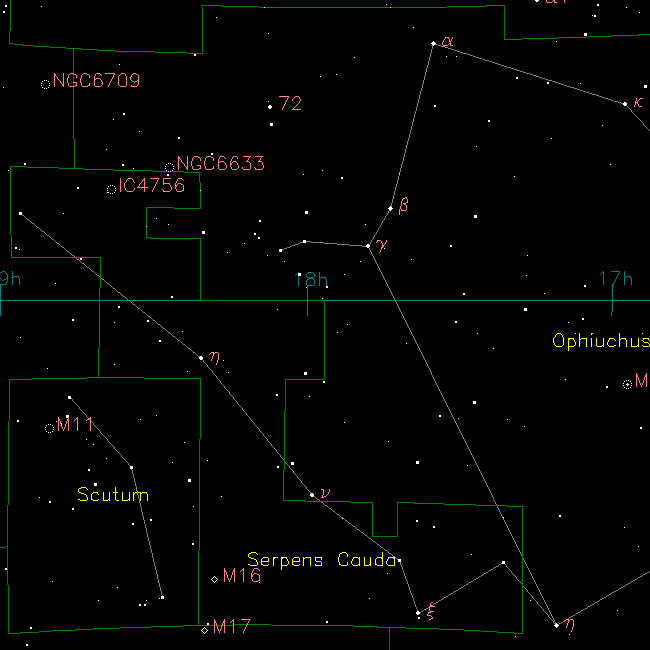[/caption]
The constellation of Serpens is unique – being the only one to be divided into two parts. Serpens Cauda represents the eastern half. Serpens was one of the 48 constellations listed by the 1st century astronomer Ptolemy and it remains one of the 88 modern constellations. The entire constellation spans 637 square degrees of sky and contains 9 main stars within its asterism and 57 Bayer Flamsteed designated stars within its confines. Serpens Caput is bordered by the constellations of Aquila, Sagittarius, Scutum and separated from its counterpart by Ophiuchus. Serpens Cauda can be seen by all observers located at latitudes between +80° and -80° and is best seen at culmination during the month of July.
In mythology, Serpens represents a huge snake held by the constellation Ophiuchus. It can either be referred to as simply “Serpens” or by its western half (Caput – the “Snake’s Head”) or its eastern half (Cauda – the “Snake’s Tail”). Ophiuchus was believed to have been the son of Apollo and a healer. According to legend, the snake is also meant to represent healing as it sheds its skin in rebirth.
Let’s begin our binocular tour of Serpens Cauda with its brightest star – Eta Serpentis – the “n” symbol on our map. Eta Serpentis is approximately 61 light years from Earth and it is an orange K-type giant star about 15 times more luminous than our Sun. Don’t forget Xi, the squiggle at the southern border, either… while it’s strictly a visual double star, this 105 light year distant group is very attractive in binoculars!
Are you ready for more? Then let’s head to M16 (RA 18 : 18.8 Dec -13 : 47). While the attendant open cluster NGC 6611 was discovered by Cheseaux in 1745-6, it was Charles Messier who cataloged the object as Messier 16. And he was the first to note the nearby nebula IC 4703, now commonly known as the Eagle. At 7000 light-years distant, this roughly 7th magnitude cluster and nebula can be spotted in binoculars, but at best it is only a hint. As part of the same giant cloud of gas and dust as neighboring M17, the Eagle is also a place of starbirth illuminated by these hot, high energy stellar youngsters which are only about five and a half million years old.
In small to mid-sized telescopes, the cluster of around 20 brighter stars comes alive with a faint nebulosity that tends to be brighter in three areas. For larger telescopes, low power is essential for Messier 16. With good conditions, it is very possible to see areas of dark obscuration and the wonderful notch where the “Pillars of Creation” are located. Immortalized by the Hubble Space Telescope, they won’t be nearly as grand or as colorful as the HST saw them, but what a thrill to know they are there!
For binoculars and all telescopes, let’s take a look a IC 4756 (RA 18 : 39.0 Dec +05 : 27). This huge, 5th magnitude open star cluster is sometimes referred to as “Graff’s Cluster”. Located about about 13,000 light years away from our solar system, you will see far more stars than you can count in this terrific field!
Sources:
Wikipedia
Chandra Observatory
SEDS
Chart Courtesy of Your Sky.

